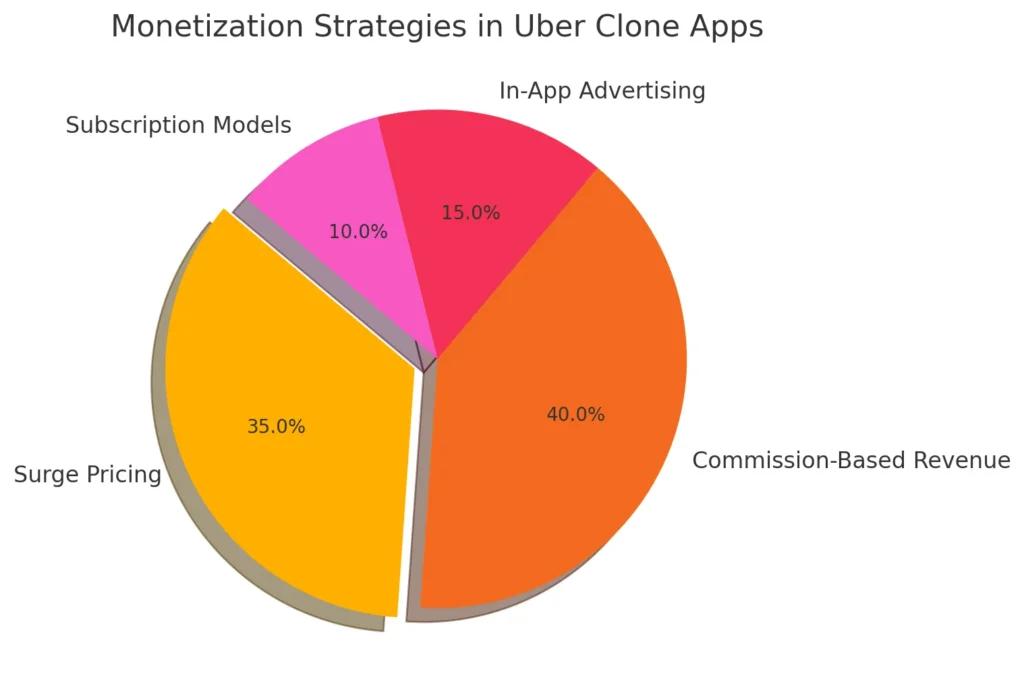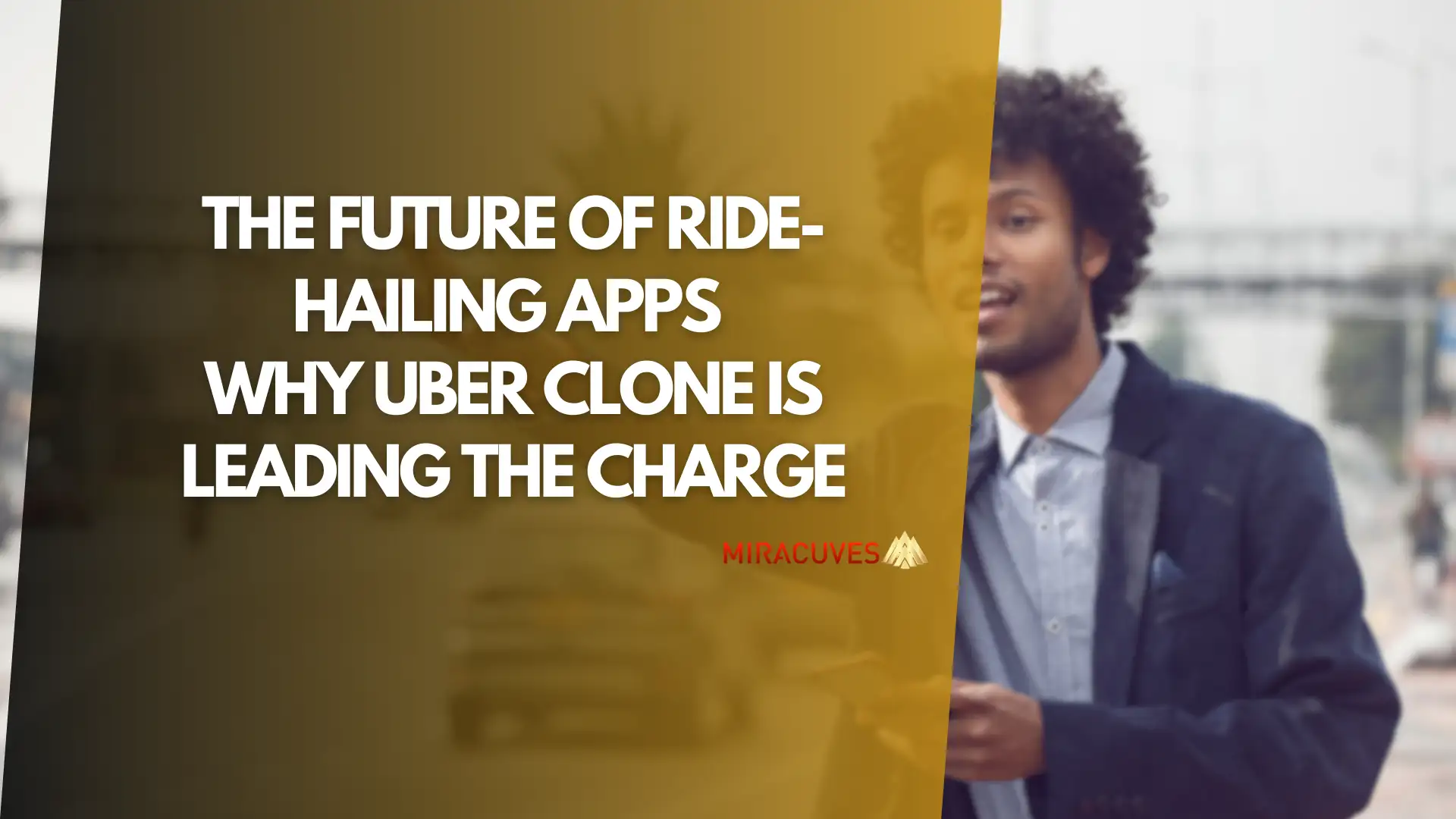In recent years, the ride-hailing industry has seen exponential growth, reshaping how people commute globally. This shift from traditional taxis to app-based ride services, like Uber, has sparked a revolution in on-demand transportation. Central to this revolution is the On demand taxi platform like uber—a ready-made solution that replicates Uber’s business model with customizable features for aspiring entrepreneurs.
As the demand for fast, convenient, and affordable rides continues to soar, the future of Uber clones holds significant promise in advancing emerging trends in ride-hailing and transforming global urban mobility.
The Evolution of Ride-Hailing: From Taxis to On-Demand Apps
The transportation industry has undergone a massive transformation, moving from traditional taxis to app-based ride-hailing services. This shift began with companies like Uber, which redefined how people access transportation by offering fast, reliable, and on-demand services with just a few taps on a smartphone. The rise of the Uber clone model capitalized on this innovation by offering ready-to-deploy solutions that allow entrepreneurs to launch similar services.
These Uber clones have evolved by incorporating custom features, regional adaptations, and scalable technology stacks to cater to different markets. From real-time ride tracking to dynamic pricing, the features that were once exclusive to industry giants are now readily available to businesses across the globe through these clones. Miracuves, with its cutting-edge Uber clone solutions, empowers entrepreneurs to leverage these on-demand transportation trends, efficiently addressing customer needs while providing the flexibility to target niche markets or offer unique transportation services.
Moreover, the rise of ride-hailing apps has significantly disrupted the taxi industry, forcing traditional companies to adopt technology and compete in a rapidly evolving market. With Uber clones now empowering businesses worldwide, the future of on-demand transportation is poised to grow even further, creating more efficient, affordable, and innovative ways to move people and goods.
Read more :- What is InDrive App and How Does It Work?
Emerging Trends in Ride-Hailing
| Trend | Description | Impact |
|---|---|---|
| AI and Machine Learning | Optimizing routes and reducing wait times | Improved efficiency and user experience |
| Eco-Friendly Vehicles | Adoption of electric and hybrid vehicles | Reduced carbon emissions |
| Autonomous Vehicles | Integration of driverless cars | Reduced operational costs |
| Micro-Mobility Solutions | Offering bikes and e-scooters for short-distance travel | Increased transportation options |
The ride-hailing industry is rapidly evolving, driven by several emerging trends that will shape its future. One of the most significant developments is the integration of artificial intelligence (AI) and machine learning in operations, such as route optimization and predictive maintenance. These technologies allow ride-hailing apps to enhance efficiency, minimize wait times, and reduce fuel consumption.
Eco-friendly transportation is another trend gaining momentum, with companies increasingly offering electric vehicles (EVs) and hybrid options to reduce carbon emissions. This push for sustainability aligns with global efforts to combat climate change and meet environmental regulations. Ride-sharing services are also on the rise, promoting lower costs and a smaller carbon footprint by allowing multiple passengers to share rides.
Autonomous vehicles (AVs) are anticipated to be the next major disruptor in the ride-hailing industry. While fully self-driving cars are still in development, many companies are investing heavily in AV technology, preparing for a future where driverless cars become a norm. Uber clone apps are poised to integrate this technology, potentially reducing labor costs and making ride-hailing more affordable in the long term.
Also Read :- Future of the Ride-Hailing Market: Autonomous Vehicles & AI Integration

In addition to these technological advancements, micro-mobility solutions like electric scooters and bikes are also emerging as viable alternatives for short-distance travel. These options cater to urban dwellers who need quick and convenient transportation in densely populated areas, adding to the diversity of transportation options within ride-hailing apps.
Autonomous vehicles are emerging as a key player in the future of ride-hailing, offering safer, more efficient rides with reduced human error. Companies are investing heavily in this technology to improve route optimization and reduce operational costs. Read more about how autonomous vehicles are shaping the future of ride-hailing at Roam.ai .
Why Uber Clones Are Leading the Charge
Uber clones have become a dominant force in the ride-hailing industry, thanks to their adaptability, cost-effectiveness, and scalability. For entrepreneurs and startups looking to enter the market, Uber clones offer a quick, efficient, and customizable solution without the need to develop an app from scratch. This is crucial in an industry that is rapidly evolving.
One of the key reasons Uber clones are leading the charge is cost-effectiveness. Building an app similar to Uber from the ground up requires significant investment in terms of development, testing, and infrastructure. Uber clones, however, come with pre-built features, reducing both time and money required to launch. Moreover, they can be tailored to specific business needs, offering flexibility for businesses to add unique features or target specific markets.
Customization and scalability are also major factors. Uber clones can be adapted to different regions and markets, allowing businesses to cater to local preferences, regulations, and customer demands. Whether it’s integrating a particular payment method or supporting a fleet of electric vehicles, these clones can be fine-tuned to meet market-specific needs, making them a future-proof solution in a highly competitive industry.
Additionally, localized and niche markets have been a significant driving factor for the success of Uber clones. Unlike large global competitors that focus on broad market appeal, Uber clones allow businesses to penetrate smaller, underserved markets or offer specialized services like luxury rides, bike taxis, or eco-friendly transport options. This ability to tailor the service has positioned Uber clones as the go-to choice for businesses worldwide, further solidifying their role in the future of ride-hailing.
Also Read :- Uber Clone vs. InDrive Clone: Choosing the Right Ride-Hailing Solution
Monetization Strategies for Uber Clones
In addition to these popular methods, Uber clones are exploring innovative revenue streams tailored to emerging user demands and market conditions. For instance, some platforms are integrating loyalty programs, where frequent users or high-rated drivers receive perks or reduced service fees, encouraging continued engagement. Partnerships with local businesses also offer avenues for exclusive in-app promotions, adding value for users while generating ad revenue. As the ride-hailing market grows, having a versatile monetization approach helps platforms adapt to shifting trends and maintain profitability. Entrepreneurs interested in delving into the diverse monetization strategies for Uber clones can explore various options here to enhance their app’s financial sustainability.
| Monetization Method | Description | Benefits |
|---|---|---|
| Surge Pricing | Dynamic pricing based on demand | Maximizes revenue during peak times |
| Commission-Based Revenue | Charging drivers a percentage of their earnings | Steady income stream |
| In-App Advertising | Selling ad space to third-party brands | Additional revenue source |
| Subscription Models | Charging a premium for exclusive services | Builds customer loyalty |
One of the core reasons for the success of Uber like apps lies in their versatile monetization strategies, which are designed to generate revenue through various channels. Key methods include:
- Surge Pricing: Increasing rates during high-demand periods, maximizing profit.
- Commission-Based Revenue: Charging drivers a percentage of their earnings for using the platform.
- In-App Advertising: Offering ad space to third-party brands.
- Subscription Models: Charging users or drivers a premium for additional features or exclusive services.

These flexible revenue models make Uber clones attractive and sustainable for both entrepreneurs and businesses.
Legal and Regulatory Challenges
As ride-hailing apps like Uber clones expand globally, navigating legal and Combination of multiple challenges becomes a critical factor for success. Each region has its own set of laws governing transportation services, including driver licensing, vehicle standards, and safety requirements. Uber clones must ensure compliance with local regulations, which may involve adjusting pricing models, ensuring insurance coverage, or adhering to specific safety guidelines.
Furthermore, labor regulations concerning gig workers are constantly evolving. Governments worldwide are reconsidering the classification of ride-hailing drivers, which may impact the business model of Uber clone apps. Companies must stay updated on labor laws to avoid costly penalties or disruptions in service.
Moreover, regulatory bodies are increasingly focused on data privacy and user protection. With personal data such as location, payment details, and ride history being collected, Uber clones need to invest in robust data security measures to comply with regulations like GDPR in Europe and similar laws in other parts of the world.
By addressing these legal and regulatory challenges head-on, Uber clones can maintain operational stability and foster customer trust, ensuring long-term growth in this competitive market.
Ready to develop your own ride-sharing app?
Request a demo today to experience how we can help you create a platform with key features like ride requests,GPS-based matching, and secure payments.
Global Expansion of Ride-Hailing Services

As ride-hailing services continue to grow, Uber clones are expanding beyond their local markets and entering the global stage. This expansion is fueled by the adaptability of Uber clone apps, which can be easily customized to meet the specific needs and regulations of different countries.
Key to this global growth is understanding local consumer behaviors and regulatory frameworks. For instance, while some regions prioritize eco-friendly vehicles, others might focus on affordability or luxury. Businesses leveraging Uber clones must ensure they integrate local payment methods, language support, and adapt to cultural expectations to thrive in new markets.
Additionally, Uber clone apps are able to scale by focusing on underserved regions, especially in developing markets where ride-hailing demand is growing. By providing solutions that are both customizable and scalable, these apps can take advantage of the rising demand for mobility services in regions where public transport infrastructure may be lacking or inefficient.
To achieve success on a global scale, Uber clone platforms also partner with local governments to ensure they meet specific regulations, such as licensing or emissions standards, while also adopting region-specific features that cater to local audiences. This global adaptability and localization of services are key reasons why Uber clones are thriving in international markets.
Technology Behind Uber Clones
| Technology | Description | Purpose |
|---|---|---|
| Real-Time GPS Tracking | Tracks rides and shows live location | Enhances ride monitoring and user trust |
| Cloud-Based Infrastructure | Handles data and app scalability | Ensures reliability and flexibility |
| Payment Integration | Supports multiple payment methods | Convenience for users and drivers |
| Blockchain for Data Security | Secures transactions and sensitive data | Protects against fraud and data breaches |
| AI and Machine Learning | Predicts demand, optimizes pricing and routes | Enhances user experience and operational efficiency |
The technology stack behind Uber clones is essential to their success and scalability. These apps rely on a combination of cutting-edge technologies to deliver seamless user experiences and efficient ride-hailing services.
- Real-Time GPS Tracking: One of the core features is real-time location tracking, which enables users and drivers to view routes, track rides, and estimate arrival times.
- Cloud-Based Infrastructure: Uber clones leverage cloud platforms to handle vast amounts of data, ensuring scalability, reliability, and secure data storage.
- Payment Integration: Secure and multiple payment gateways, such as credit cards, digital wallets, and local payment methods, are integrated for convenience.
- Blockchain for Data Security: As data privacy becomes more critical, blockchain technology is increasingly being integrated to secure user data and protect financial transactions.
- Artificial Intelligence (AI) and Machine Learning (ML): AI and ML are used to enhance route optimization, dynamic pricing, and customer service via automated chatbots.
This robust tech infrastructure not only allows for customization and scalability but also ensures the future of Uber clone apps remains competitive, efficient, and secure as the market continues to evolve.
Blockchain technology is transforming the ride-hailing industry by enhancing data security and transparency, rebuilding trust between riders and drivers. This innovative approach ensures tamper-proof transactions and reliable service.
Data Analytics and Personalization
Data analytics plays a pivotal role in enhancing the user experience and operational efficiency of Uber clones. By leveraging advanced analytics, these apps can monitor rider preferences, optimize routes, predict demand, and reduce wait times.
Personalization is another key aspect, with Uber clones using customer data to offer tailored services, such as recommended routes, personalized offers, and dynamic pricing. Machine learning algorithms help predict peak hours, ensuring sufficient driver availability and reducing customer dissatisfaction. This data-driven approach is vital in retaining users and improving ride-hailing services.
Competition in the Ride-Hailing Market
The ride-hailing industry is fiercely competitive, with established giants like Uber and Lyft battling for market share alongside local and regional services. Uber clones are capitalizing on this by offering adaptable, cost-effective solutions that cater to niche markets and specific geographic regions. Unlike larger players, Uber clones can focus on localized strategies, customizing their platforms for different regulations, languages, and customer preferences.
This flexibility allows Uber clones to thrive in emerging markets and underserved areas, where they can quickly establish a presence and compete against bigger companies by offering specialized services or competitive pricing models. As ride-hailing continues to grow, Uber clones have proven their ability to challenge even the biggest competitors by being nimble and market-focused.
User Experience and Customer Loyalty
In the competitive ride-hailing market, user experience (UX) is paramount for building customer loyalty. Uber clones focus heavily on providing a seamless and intuitive interface, ensuring users can quickly book rides, track drivers, and complete payments without friction. Features such as driver ratings, ride history, and personalized offers help enhance customer satisfaction and retention.
Building loyalty often includes implementing reward systems, discounts, or referral programs to keep users engaged and returning to the platform. By continuously improving UX and offering incentives, Uber clones maintain a competitive edge and foster long-term customer relationships.
The Future of Uber Clone: What’s Next?
As the ride-hailing industry evolves, Uber clones are well-positioned to integrate future technologies and trends. One of the most anticipated developments is the integration of autonomous vehicles, which could significantly lower operational costs by eliminating the need for drivers. Additionally, the focus on sustainability will push Uber clones toward adopting electric vehicles and eco-friendly transportation options.
Moreover, the rise of Mobility-as-a-Service (MaaS) platforms will enable seamless multi-modal transportation services, combining ride-hailing with public transport, bikes, and scooters. As smart cities become more common, Uber clones are expected to incorporate these advancements, offering even more integrated and user-friendly services.
The future of Uber clones lies in their ability to adapt to these emerging trends in ride-hailing, ensuring they remain at the forefront of the industry.
Conclusion
The future of ride-hailing is rapidly advancing, and Uber clones are playing a pivotal role in driving this evolution. From leveraging new technologies like AI, data analytics, and autonomous vehicles to adapting for niche markets, Uber clones offer a flexible, scalable, and cost-effective solution for entrepreneurs in the mobility industry. By staying ahead of emerging trends in ride-hailing, these platforms are shaping the future of urban transportation, providing sustainable, customizable, and innovative solutions that meet the ever-changing demands of consumers globally.
If you’re looking to build a cutting-edge ride-hailing app like an Uber clone, Miracuves can help you take the lead. Our custom, scalable solutions are tailored to your business needs, ensuring a seamless experience for both riders and drivers. With innovative features, top-notch security, and future-ready technology, we enable you to enter the ride-hailing market quickly and effectively. Ready to launch your Uber clone? Contact Miracuves today and transform your ride-hailing business vision into reality!
Visit Miracuves for more details!
Ready to launch your own ride-sharing app?
Let us help you incorporate essential features like ride
scheduling, driver ratings, and real-time notifications
into your platform.
FAQs
What is an Uber Clone and how does it work?
An Uber clone is a ready-made app solution replicating Uber’s business model. It includes features like ride-booking, GPS tracking, and payment gateways, allowing businesses to quickly launch their own ride-hailing service.
Why are Uber clones popular for entrepreneurs?
Uber clones are cost-effective and customizable, allowing businesses to enter the ride-hailing market quickly. They can be adapted to local preferences, regulations, and unique features, making them scalable and future-proof.
What are the emerging trends in the ride-hailing industry?
Key trends include AI and machine learning for route optimization, electric and eco-friendly vehicles, autonomous cars, and micro-mobility solutions like e-scooters and bikes.
How do Uber clones handle legal and regulatory challenges?
Uber clones must comply with local transportation regulations, data privacy laws, and labor rules, ensuring their services are legally compliant and safe for users and drivers.
What technologies power Uber clone apps?
Uber clones use a tech stack that includes real-time GPS tracking, cloud infrastructure, payment integrations, AI for ride optimization, and blockchain for secure data handling.
What are the monetization strategies for Uber clones?
Uber clones generate revenue through surge pricing, commission-based models, in-app advertising, and subscription services for premium features or exclusive rides.
Related Article:








